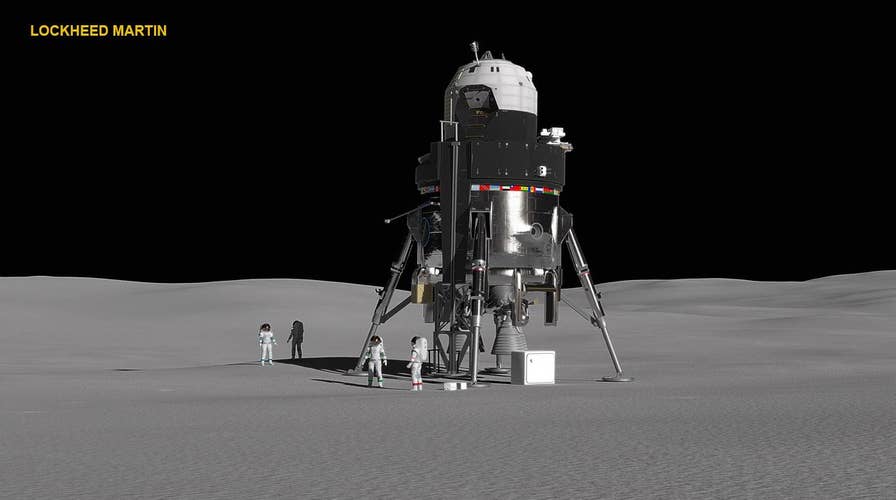Lockheed Martin unveils new lunar lander
Lockheed Martin has unveiled a new lunar lander prototype, the Mars Base Camp Precursor Lunar Lander, that would let astronauts stay on the Moon for up to two weeks. The spacecraft would use the Lunar Orbital Platform-Gateway as its home base, which NASA said will start building near the Moon in 2022.
NASA announced that Lockheed Martin and eight other companies will compete for $2.6 billion worth of contracts to help take American astronauts back to the Moon and Mars.
NASA administrator Jim Bridenstine made the announcement at the James Webb Auditorium at NASA headquarters in Washington. In addition to Lockheed, which built the Mars InSight lander that touched the surface of the Red Planet earlier this week, NASA's commercial partners include Astrobotic Technology, Deep Space System, Draper, Firefly, Intuitive Machines, Masten Space Systems, Moon Express and Orbit Beyond.
The contracts could be worth as much as $2.6 billion over a span of 10 years and flights could start as soon as next year, officials said. The original list included more than 30 companies vying for the bids, including Elon Musk's SpaceX and Jeff Bezos' Blue Origin.
TO THE MOON AND BACK: APOLLO 11 LUNAR CHECKLIST OFFERS GLIMPSE INTO HISTORIC MISSION
Brindenstine stressed that this would not be like past initiatives to return to the Moon which failed, saying that NASA was "spreading the risk" and "lowering the cost with multiple commercial partners." "This is not going to be Lucy and the football again," Bridenstine said. "We're not going to plan to go to the Moon and not go to the Moon. We have more partners than ever before and their level of excitement is higher than it's ever been."
Bridenstine likened it to venture capital — "we're taking shots on goal," he said, adding that the space agency would have some risk, but a greater reward because of its commercial partners. "We want medium-class landers, we want large-class landers and we want human-class landers. We also want to get there fast."
In addition, Bridenstine, a former congressman from Oklahoma, said NASA would be conducting scientific experiments on the surface of the Moon, taking heed from the scientific community. "We believe there is a lot of amazing science we can do on the surface of the Moon," Bridenstine said during the presentation.
Thomas Zurbuchen, associate administrator for NASA’s Science Mission Directorate, said there is water on the Moon and the upcoming scientific experiments will help humanity learn how to use these resources to further science.
The Trump administration has cited Moon missions a key element of the 2019 NASA budget. President Donald Trump wants U.S. astronauts to return to the Moon as a foundation for future Mars missions.
Asked how NASA is working to cut down on the radiation exposure for astronauts, Bridenstine said the space agency is working on different propulsion capabilities, including potentially nuclear electric propulsion or nuclear propulsion to cut the time of the trips down. NASA is working providing "as much protection as we can," adding that it's "a big problem and we're working on it."
In December, Trump signed a policy directive instructing NASA to "refocus America's space program on human exploration and discovery." The move, Trump said, "marks an important step in returning American astronauts to the Moon for the first time since 1972 for long-time exploration."
The last time a human set foot on the Moon was during the Apollo 17 mission in December 1972. Only 12 men, all Americans, have set foot on the Moon.
Mars also looms large in America’s space future. NASA’s long-term goal is to send a manned mission to the Red Planet in the 2030s.
NASA’S INSIGHT MARS LANDER ARRIVES ON THE RED PLANET, ENDS SUCCESSFUL JOURNEY
As part this effort, NASA’s unmanned InSight Lander touched down on the Martian surface Monday, becoming the space agency’s first probe to reach the Red Planet in six years.
Zurbuchen said the timeline to get the Moon was unprecedented, saying "we've never done anything this fast." He added that some of the experiments that will be performed on the Moon are already out there and there are some instruments that are already in place to help with these experiments.
The Associated Press contributed to this article. Follow James Rogers and Chris Ciaccia on Twitter @jamesjrogers and @Chris_Ciaccia





















